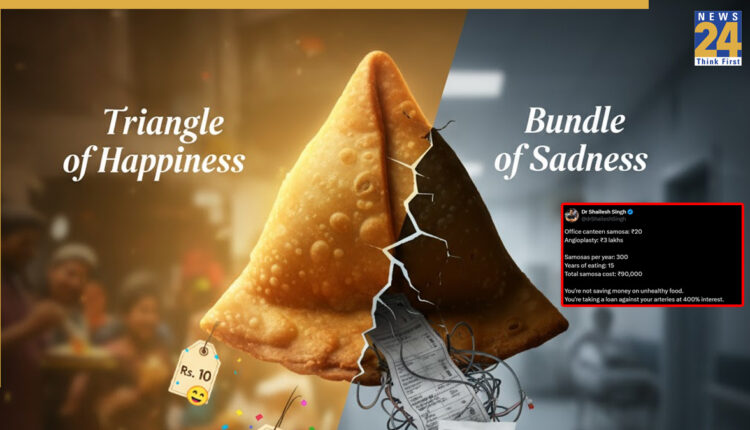When in Doubt Don’t Eat A SAMOSA…: A ‘Triangle of Happiness’ Worth Rs. 20 Turns into a ‘Bundle of Sadness’ with 3 Lakh Medical bill
Health News: What began as a humorous message quickly turned into a wake-up call for thousands of people. Everyone is reconsidering their snack selections after seeing a recent viral post that contrasted the cost of an angioplasty with that of an office canteen samosa. The topic of arithmetic and its meaning was often discussed on the internet.
A Viral Post, A Powerful Message
Cardiologist Dr. Shailesh Singh of Delhi wrote on his Twitter account (formerly X): “Office canteen samosa: ₹20, ₹3 lakhs for an angioplasty. Annually, 300 Samosas Years of consumption: 15, the total cost of the samosas was ₹90,000. You are taking out a 400% interest debt against your arteries rather than saving money on bad food.”
Office canteen samosa: ₹20
Angioplasty: ₹3 lakhsSamosas per year: 300
Years of eating: 15
Total samosa cost: ₹90,000You’re not saving money on unhealthy food.
You’re taking a loan against your arteries at 400% interest.— Dr Shailesh Singh (@drShaileshSingh) October 23, 2025
Samosa- More Than Just a Golden Triangle
The majority of us have a fondness for samosas. These tea break buddies are warm, crunchy, and delicious. However, there is a combination of substances behind that golden triangle that can seriously harm the heart. A little samosa can have 240 calories and a lot of saturated fat and refined carbohydrates. But the oil it’s fried in—not the potato or the flour—is the true issue.
Samosa: Beware of Your Cholesterol
The worst type of fat for your body, trans fats, are produced when oil is heated repeatedly, as is the case with street sellers and canteens. These fats decrease good cholesterol, increase bad cholesterol, and clog arteries. They raise the risk of high blood pressure, diabetes, and heart attacks over time. A seemingly non-toxic food can slowly destroy the health of your heart.
ALSO READ: Travel Mumbai to Goa in Just 6 Hours: New 466-KM Expressway Nears Completion After 14-Year Delay, Aims to Cut Journey Time – Details Inside
The purpose of the widely shared message was not to put samosa lovers in confusion or guilt. In terms of perspective, it demonstrated how we frequently believe that by selecting the “quick snack,” we are saving money or time, but in actuality, we are borrowing against our future health. Today, it may seem simple to ignore early warning symptoms like fatigue or chest pain, skip exercise, or eat fried food every day. However, the body will finally deliver its charge, which may be much more costly than we had anticipated.

